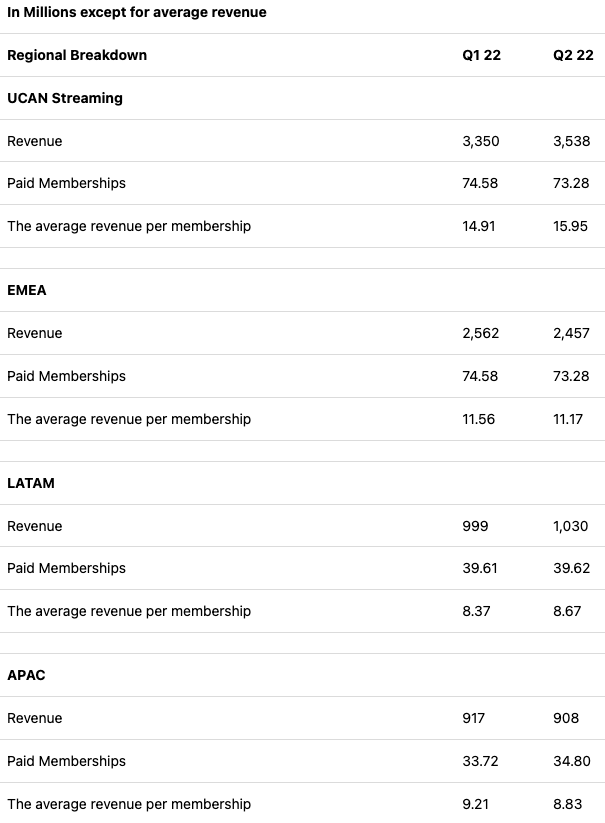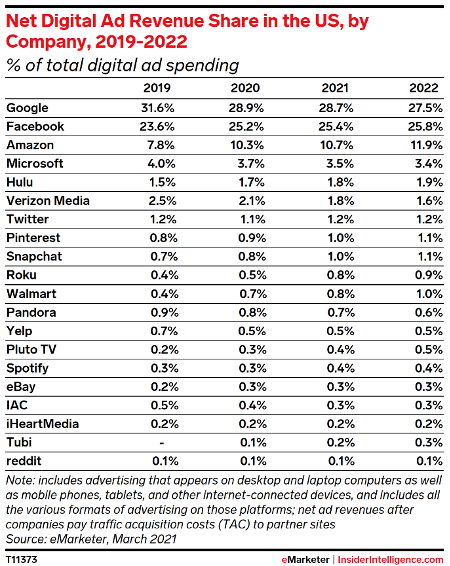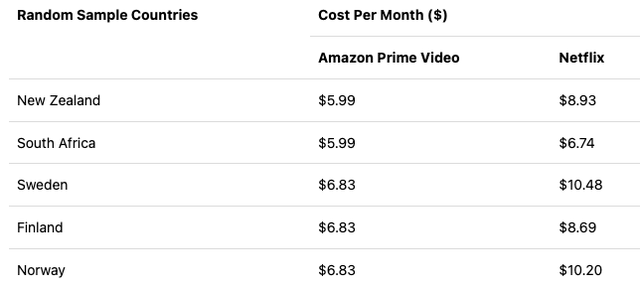hocus-focus
This article was originally published for members of Leads From Gurus on July 26 and updated on September 20.
“It is not the strongest of species that survives, nor the most intelligent that survives. It is the one that is most adaptable to change.” – Charles Darwin
Netflix, Inc. (NASDAQ:NFLX) is currently in a difficult phase in business with decelerating growth due to declining discretionary spending and the company is also faced with the most aggressive competition since its inception with the likes of The Walt Disney Company (DIS) and Amazon.com, Inc. (AMZN) establishing their presence in key markets such as the U.S. and India. Netflix’s approach has always been to keep its business model as simple as possible within the context of its growth objectives. But amid declining subscriber growth, the company is now forced to evolve and adapt, which is likely to complicate its business model. Nonetheless, these changes are necessary to secure sustainable earnings growth in the long run.
Many investors have been following Netflix very closely in the last few months given the lackluster subscriber additions and the downgrades by the likes of Goldman Sachs (GS), UBS Group AG (UBS), and many other Wall Street analysts before the Q2 earnings release. Netflix, however, pleasantly surprised the market with earnings exceeding analyst expectations and in particular, reporting a subscriber loss of 970,000 in Q2 which was considerably lower than the initially guided 2,000,000.
In this article, I will discuss how Netflix is turning a corner with its ad-supported content tier along with much-needed changes to its content policy.
What We Know About The Ad-Supported Content Tier
Netflix initially hinted about an ad-based model in April this year and announced in July that it is set to partner with Microsoft Corporation (MSFT) in this endeavor targeting to launch in the early part of 2023. According to several reports published by renowned entertainment outlets recently, Netflix is reportedly moving up the timeline of the launch of this ad-supported tier to November 1 to get ahead of Disney+ which is planning to launch its ad-supported tier on December 8.
Based on management commentary, this ad-supported tier will be launched in a few selected markets where advertising spending is already high. With the U.S. being the country with the largest spending on digital ads and the region where Netflix derives its biggest chunk of revenue, Netflix will likely launch this content tier in the United States before focusing on other key markets. According to Variety, Netflix will launch the ad-supported tier in the U.S., Canada, UK, France, and Germany.
Exhibit 1: Netflix revenue breakdown
Q2 shareholder letter
Netflix is not the first to adopt this strategy as Hulu and HBO Max already offer ad-based plans that are more economical than their ad-free services. Disney+ is also on the verge of joining the streaming platforms that are offering ad-supported streaming.
The best example Netflix can use as a reference would be Hulu with Netflix CEO even calling the model a success in April 2022. With a subscriber count of approximately 40 million, Hulu generates close to $3 billion in advertisement revenue per annum. As per Insider Intelligence, this is close to 1.8% of total digital ad spend in the United States.
Exhibit 2: Digital ad revenue share in the U.S. by company
Insider Intelligence
Having partnered with Microsoft, it will be important to see how the company approaches the situation as this is not part of its core business model. It is an advantage being the largest streaming business in the world with a significant number of minutes viewed by subscribers on its platform. This massive subscriber base and engagement rate places Netflix in a good position with potential advertisers, which in turn could create a reliable revenue stream in the long run. I believe the international segment is where Netflix is set to benefit from its ad-based plan the most. This segment was expected to be the next growth driver for the company, however, things have not gone according to plan due to lower-priced offerings by competitors. Except for the APAC region, the subscriber count has declined in every other region in the last couple of quarters. I believe an ad-based, low-price offering will help Netflix revive growth in all these regions.
Exhibit 3: Cost comparison between Netflix and Amazon Prime Video
This is also a double-edged sword situation for Netflix, as subscribers in large quantities may switch to the lower-priced ad-based plan resulting in cannibalization of revenue. But given the fact that the full implementation of this content tier is likely to take effect over a few years, it allows the company management to test it out and achieve a sustainable solution that does not limit the long-term growth potential of the company.
Wall Street Analysts Are Making A U-turn on NFLX
Netflix is no longer a darling of Wall Street. So far this year, Netflix has not received a lot of love from analysts because of the continued decline in subscribers and inflationary concerns. The expected launch of the ad-supported content tier, however, has triggered a wave of analyst upgrades. This is not surprising given that Netflix could become one of the biggest players in the global advertising industry in the long run.
Oppenheimer analyst Jason Helfstein who has a price target of $325 for NFLX recently upgraded Netflix to outperform and wrote in a note to clients:
Netflix is in a unique position to aggregate large audiences and control the timing of series launches for top-tier advertisers.
Last week, Citigroup analyst Jason Bazinet raised his price target for Netflix from $275 to $305 and claimed that Netflix could win about 65 million global subscribers with its ad-supported tier. Speaking to Yahoo Finance, the analyst said:
Netflix doesn’t have a natural shareholder base. It’s not adding subs, so it’s not a growth stock. It doesn’t have a lot of cash flow, so it’s not a value stock but if 65 million new customers sign up, we could go back into growth mode.
The praise Netflix is getting from Wall Street analysts could be helpful in boosting investor confidence in the company.
Netflix’s Content Strategy
Over the last few years, Netflix has been spending staggering amounts of money on content creation, which was in line with its aggressive growth strategy. In 2021, Netflix spent $17.7 billion on content compared to $11.8 billion in 2020. In order to cater to a larger audience, the company was focused on expanding to different varieties of titles in its library and transforming its service from licensed, second-run content to mostly original content. As per company filings, 60% of net content assets on its balance sheet today are Netflix-produced. As highlighted in the second-quarter shareholder letter, going forward, the company will not try to expand into new content categories and this will be reflected in decreasing cash content spend to content amortization ratio.
The company is looking to maintain content costs at current levels but focus on popular hits. This is highlighted with titles such as Gray Man which is its most expensive project costing $200 million, featuring Ryan Gosling and Chris Evans. The company has identified the importance of titles such as Stranger Things that can “influence pop culture, build passion for Netflix and create an experience that is differentiated and difficult to replicate.” The company also wants to expand on these big-budget projects by creating an additional revenue stream through spin-offs, which was explicitly mentioned by the directors of Gray Man who confirmed the movie was created with expansions outside of Netflix in mind.
I believe Netflix will not cut down on content creation costs but will focus on creating titles that will bring more bang for the buck. This is a good strategy to drive the engagement rate higher and subscriber churn lower in the short to medium run, but in the long run, this strategy could cost the company potential subscribers as certain audiences will run out of content to love on Netflix. That being said, Netflix might have to lose certain types of subscribers today to revive subscriber growth in the long run.
The company does not plan to cut down spending on non-English programming in key regions, which is an encouraging sign, although this decision may cap earnings growth in the short run.
Overall, Netflix is making important changes to its content strategy, and investors will have to wait a few more quarters to see the impact of these changes on corporate earnings, subscriber churn, and engagement levels. As an investor, I am leaning on the positive side as I believe these changes are necessary to secure the long-term sustainability of Netflix’s earnings.
Takeaway
Netflix is in a consolidation phase. Although the company faces many hurdles today in the form of macroeconomic challenges and competition, I believe long-term trends are still intact and that subscriber growth will once again turn positive when the company rolls out the planned ad-supported content tier. It is not reasonable to expect the company to replicate the growth seen in the last decade given the intense competition in the industry. Patience will be needed for us to see better days with our investment in Netflix but there is no need to panic despite all the negative chatter surrounding the company.



Be the first to comment